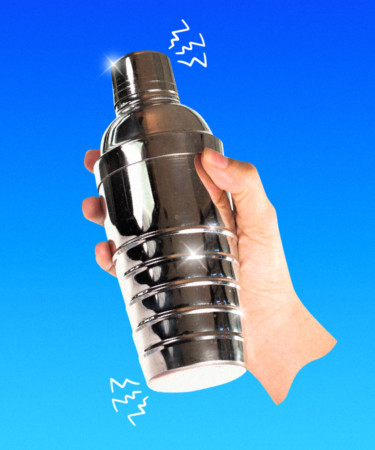The cocktail shaker is an essential tool for every mixologist, from novice to certified professional. If you’ve spent any time at a bar, you’ve likely witnessed the display of entertainment that is a bartender shaking a cocktail around the back of their head before elegantly straining the contents into a glass. Whether you’ve taken one for a spin yourself or simply find yourself admiring the flashy mixology happening behind the bar on nights out, the cocktail shaker is an accessory certain to catch your eye.
The history of mixing drinks dates back as far as 7000 B.C., as proven by fragments of gourd containing traces of alcohol found in South America by archeologists. The first mention of what would later become the modern cocktail shaker appears in a 1520 letter by Spanish explorer Hernando Cortez, who wrote of cacao mixtures made in a “golden cylinder-shaped container.”
While first mentioned in the 16th century, the cocktail shaker as we know it today did not become a staple behind the bar until the mid-1800s. The modern cocktail shaker is likely a derivative of a simpler, albeit much messier, means of cocktail mixing — sticking two glasses together and shaking. It is impossible to say who was first to use a cocktail shaker, and even harder to determine who invented the tool, but The New York Times cites George Foster, a reporter for the New York Tribune, as being the first to observe the practice. “With his shirt sleeves rolled up, and his face in a fiery glow,” Foster wrote in 1848, “[he] seems to be pulling long ribbons of julep out of a tin cup.”
By the end of the 19th century, three distinct versions of the original cocktail shaker had been invented, and they still prevail today — the French, the Boston, and the cobbler shaker.
The first cocktail shakers were early forms of the Boston shaker, a two-piece combination of a 16-ounce mixing tin or glass and 28-ounce metal tin shaker. It’s important to note that while a mixing glass may be of similar size and appearance to a pint glass, they are not interchangeable. A mixing glass has been created with the explicit purpose of shaking cocktails, and thus has been heat-treated accordingly. If you swap in a pint glass for a mixing glass, it’s likely the weaker glass would chip into the cocktail.
The Boston shaker prevailed in terms of popularity in the United States when shakers were first introduced, but it was the French shaker that dominated at European bars. Rather than using a glass to mix cocktails, the French shaker consists of two tin pieces, with a top acting as a lid. While the aesthetics are simple and sleek, the French shaker requires bartenders to use a separate strainer, preventing the style from ever gaining popularity stateside.
Invented by Edward Hauck in 1884, the Cobbler shaker may be the version of the cocktail shaker you’re most familiar with. It derives from the Boston shaker, but instead is an all-in-one mixing tool consisting of a metal tin, cap, and strainer. The name of the Cobbler shaker is said to come from the Sherry Cobbler, a famous 19th-century cocktail that needed to be shaken and then strained.
While early versions of the cocktail shaker were made from a variety of materials, when stainless steel was invented in 1913, it quickly became the primary material used for cocktail shakers. By the 1920s, it was general consensus among bartenders and drinks lovers alike that stainless steel was the best due to its rust-resistant and long-lasting qualities — and it remains the material of choice for shakers today.
